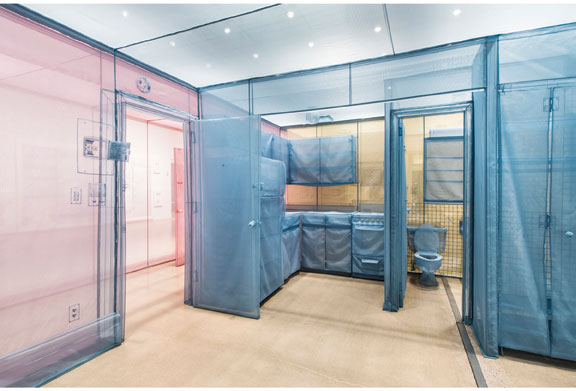« Reviews
Do Ho Suh
Museum of Contemporary Art - Cleveland
By Tim Hadfield
Hauntingly beautiful, Do Ho Suh’s installation and exhibition at MOCA Cleveland indelibly fixes itself into collective memory. This show, comprised of diverse works addressing the meaning of home, habitation, relocation and identity engages the peripatetic life of the artist.
Having originally moved to the United States from South Korea in 1991, Suh now lives in New York, London and Seoul. “It sounds like such a cliché, but for me home is ultimately where the heart is,” says Suh after over three decades of international travel and relocation. The installation explores, through mixed-media works on paper, “rubbings” derived from surfaces of former homes, and “specimen” sculptures, Suh’s life. The centerpiece, Apartment A, 348 West 22nd Street, is a stunning, same-scale reconstruction in translucent polyester fabric of two adjoining apartments when the artist lived in New York City.
Single hues represent each small, interconnected room: blue, pink, yellow, red. Succulent though the color may be, the transparency of the fabric makes the walls delicate washes of watercolor, glowing, shifting, overlapping, just in touch with the floor.

Do Ho Suh, Apartment A, Unit 2, Corridor and Staircase, 348 West 22nd Street, New York, NY 10011, USA (detail), 2011–2014, polyester fabric and stainless steel tubes. Installation view, MOCA Cleveland, 2015. Photo: Jerry Birchfield. © MOCA Cleveland.
Visitors navigate through empty rooms and corridors of extraordinary detail: A doorknob sags slightly under the weight of its polyester dermis; a fuse box, millimeter-perfect in every semi-transparent detail, wills the flick of its breaker switch; throbbing red stairs wilt at the treads and lead nowhere. Carved from the original row house, devoid of furniture and belongings, the empty rooms of this one-floor apartment celebrate the ordinariness of each light fitting, radiator and electrical socket. Then more substance: a blue kitchen equipped with stove and refrigerator, a full en suite bathroom. Each tiny space, translucent layer upon layer, melts and floats into the other, walls and fittings simultaneously overlapping like gently colored X-rays.
Suh connects us to these spaces through the empty anonymity of fiercely ubiquitous interiors. Is this the ghost of an interior, its shucked-off skin? The piece dazzles with its beauty and sublime craft.
Both perceptually and physically fragile, Suh’s installation suggests a metaphor for the beauty and impermanence of memory and how it is linked to a sense of place. While Suh spellbinds with the veracity of his re-created apartment he evokes an empathic response to shared memories-causing us to question our own experiences and understandings of home and belonging.
Suh’s individual “Specimen Series” pieces are the most powerful of the remaining works. Constructed of polyester and enclosed in light boxes, single objects such as a stove, toilet and bathtub, now autonomous pieces, evoke a lower-key presence than the apartment installation. The isolated objects are floating in light boxes, taut exoskeletons fluorescing like jellyfish under a black light. Empty of body, skin lit at the edges, they hum, exuding a sinister self-confidence, waiting for their master to return.
Suh’s substantial and seductive work should be experienced in person, for one needs to enter the work to have its intensity revealed-like home.
(September 25, 2015 - January 10, 2016)
Tim Hadfield is a British artist and curator living in Pittsburgh, where he is a professor of media arts at Robert Morris University. He has exhibited widely in the United States and Europe and has been represented by galleries in England, Holland, Germany and the U.S. He has taught at many renowned art institutions, including Carnegie Mellon University in Pittsburgh; Savannah College of Art & Design; and The University of the Arts and the Royal College of Art, both in London. Hadfield is also a Fellow of the Royal Society of Arts.
Filed Under: Reviews



































Leave a Reply
You must be logged in to post a comment.